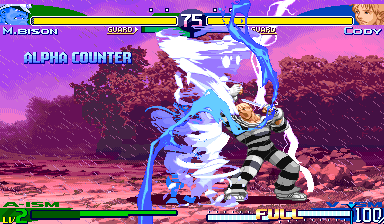Having investigated SF4 a little further, it’s apparent that the entire combo engine is based on a list of special properties arbitrarily assigned to various moves. In order to predict exactly what will combo into what, we need to put together a comprehensive chart of these traits by testing every attack.
Here’s an incomplete list of specialized attack properties i’ve encountered while experimenting primarily with Ryu, Zangief, El Fuerte, and Ken:
– always creates a juggle state against a grounded opponent
– always creates a juggle state against an airborne opponent
– only creates a juggle state against a non-reeling airborne opponent
– only creates a juggle state against a reeling airborne opponent
– resets the juggle counter without creating a juggle state
– possesses an inherent juggle potential of __ (some integer)
– knocks down on counterhit
– always renders opponents invincible
– renders grounded opponents invincible
– renders airborne opponents invincible
When an opponent gets knocked down through conventional means, they can only be juggled by an attack with a juggle potential of one or greater. After they’ve been juggled once, they can only be juggled by an attack with juggle potential of two or greater, and so on. Generally whenever an attack creates a juggle state, it also resets the juggle counter.
For example, the first hit of Ken’s MP Shoryuken has no inherent juggle potential and knocks down on counterhit. The second hit possesses an inherent juggle potential of one.
The first hit of Ken’s HP Shoryuken only creates a juggle state against a non-reeling airborne opponent, knocks down on counterhit which satisfies the airborne condition for creating a juggle state, and has no inherent juggle potential. The second hit only creates a juggle state against a reeling airborne opponent and has no inherent juggle potential. The third hit has a juggle potential of one.
Continue reading →
